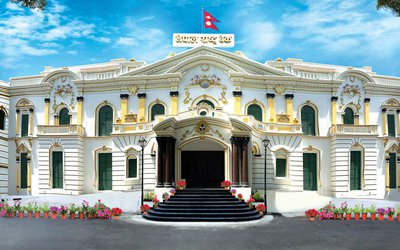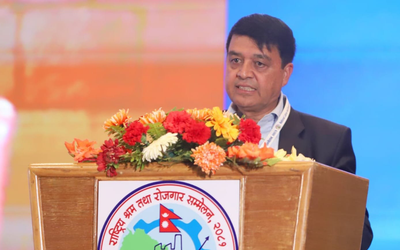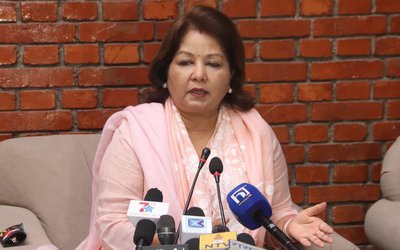
Madhu Kumar Marasini, Secretary, Ministry of Industry, Commerce and Supplies, pointed out that Nepal needs to think outside the conventional approaches and explore new products to export to the US in which Nepal has comparative advantage.
He said the government is proposing that more products of export interest to Nepal be included in the US’s trade preferences for Nepal.
Addressing a roundtable discussion organized by South Asia Watch on Trade, Economics and Environment (SAWTEE) in association with The Asia Foundation, to discuss the prospects and challenges of exporting to the US, Secretary Marasini also highlighted the importance of services trade, such as IT exports, for which government intends to ease the process.
Despite being granted duty free access to 77 products by the US, Nepal’s export performance in those select products is dismal. Limited utilization of trade preferences necessitates a careful examination of the constraints faced by exporters if Nepal aims at improving export performance through such facilities, experts said during a discussion event held today.
A SAWTEE study on Nepal-US trade, presented at the event, finds that Nepal’s merchandise exports to the US in 2021, at US$108.3 million, were lower than what they were at their peak in the late 1990s even in nominal terms.
The US granted duty-free access to Nepal on an additional 77 products under the Nepal Trade Preference Programme (NTPP), introduced through a legislation and enforced from December-end 2016. The scheme was unveiled to help Nepal recover from the devastating earthquakes of 2015. It will last till 31 December 2025.

As per the study, while total goods exports to the US have been on an upward trend since 2012, exports of NTPP products have been on a downward trend, the study finds. Exports of NTPP products in 2021 were U$8.47 million and had a share of 7.8 percent in total exports to the US (compared to 14 percent in 2012). The utilization of NTPP remains low, at under 50 percent, compared to another duty-free scheme of the US, the Generalized System of Preferences, which Nepal also benefits from.
Presenting the study, Dr. Paras Kharel, Executive Director, SAWTEE, added that it is crucial to address productive capacity and supply-side constraints, highlighting that even if the available preferences were fully utilized, it would not lead to a dramatic increase in exports of these products without resolving the underlying constraints in production and supply.
Kiran Saakha, President, Nepal-USA Chamber of Commerce and Industry, pointed out that the end of global quotas on textiles and clothing in the early 2000s dealt a severe blow to Nepal’s exports to the US as exports of readymade garments, which accounted for over 80 percent of Nepal’s exports to the US at that time, plunged.
He highlighted the existing export potential with respect to the US market, citing the example of Nepali handknotted carpets, which he said were being bought be American consumers despite being significantly more expensive than their competition on account of their high quality. He urged the governments of Nepal and the US to provide meaningful assistance to exporters.
Purushottam Ojha, Former Secretary, Ministry of Industry, Commerce and Supplies (MoICS), Government of Nepal, said Nepal’s Commerce Policy and Nepal Trade Integration Strategy, which have identified priority products, should be the basis for negotiating an extension to the trade preferences provided by the US.
Shankar Prasad Pandey, President, Federation of Export Entrepreneurs Nepal (FEEN), said precise items of export interest to Nepal should be identified when seeking an extension of the US’ trade preference programme for Nepal. He expressed concern over the underutilization of the provision for technical assistance and capacity building under the TIFA. According to Mr. Pandey, Nepal must establish clear objectives regarding the kind of technical assistance required from the US to ensure optimal utilization.

Vidushi Rana, Executive Director, Goldstar Shoes, highlighted the huge potential and demand for Nepali footwear in the US and the prohibitively high tariff it faces there, and urged the US government to include footwear in the list of preference-granted products, given the industry’s role in inclusive growth and job creation.
Ajit Bikram Shah, Founding member and Chairperson, The American Chamber of Commerce in Nepal (AMCHAM), expressed the need for Nepal to strengthen its negotiation skills to tap its export potential in the US market.
The participants in the roundtable discussion called attention to the need for support in promoting Nepali products in the US through trade fairs, and expanding the product coverage of the NTPP if the latter is extended. They emphasized the need for the utilization of the capacity building and technical assistance component of the NTPP and the Nepal-US Trade and Investment Framework Agreement (TIFA) to enhance the productive capacity of Nepali exporters.
The event saw the participation of around four dozen participants, including trade experts, policymakers, exporters, freight forwarders and representatives from the US Embassy in Nepal.
- Exports Increase By 46.5 Percent
- Mar 12, 2025
- Weather Forecast: Partly To Generally Cloudy With Rain in Few Places of Koshi, Bagmati and Gandaki Provinces
- Mar 12, 2025
- Nepal Investment Mega Bank Chairman Prithvi Bahadur Pande Takes Oath.
- Mar 11, 2025
- FM Dr. Deuba Left For India Visit
- Mar 11, 2025
- FNCCI President Dhakal Prioritizes Industrial Environment For Job Creation In The Country
- Mar 11, 2025















